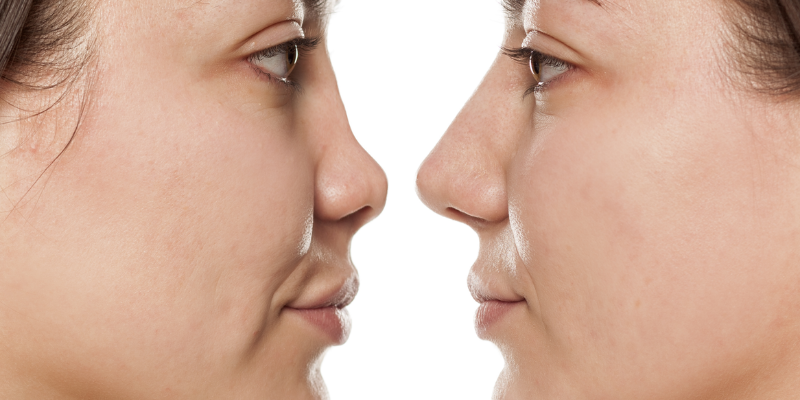Nonsurgical Rhinoplasty
What’s nonsurgical rhinoplasty? Because it doesn’t hurt and is simple to obtain, non-surgical rhinoplasty has been popular for a while. As you can see from the non-surgical rhinoplasty before and after photos, it produces amazing results. Unfortunately, the most effective methods were developed using Caucasian basic face shapes and ideals of beauty. Given that the majority of patients in the United States are Caucasians, this makes it difficult for people of colour to achieve positive outcomes. Rhinoplasty, also known as “nose work,” is performed on approximately 74% of the population who are white. However, a narrow, all-inclusive focus on the “American nose” ignores the diverse range of face shapes and characteristics in contemporary culture as well as people’s ethnic identities.
A person of African-American, Asian, Native American, or Middle Eastern descent may have trouble breathing and be more likely to require additional or revision treatments if Caucasian rhinoplasty criteria are applied to their face.
Ethnic rhinoplasty is also known as reduction rhinoplasty. Compared to conventional nose jobs, which are typically performed on Caucasians, that is very different. Remove the cartilage and bone. On the other hand, Asians and African Americans can have cartilage implanted or their noses made larger. The method is renowned for improving appearances without erasing ethnic features.
What’s Nonsurgical Rhinoplasty?
Qualified surgeons with extensive knowledge, training, and an understanding of how the faces of various ethnic groups should appear can perform ethnic rhinoplasty. In this research project, a novel surgical procedure will be performed. In these procedures, grafts and other materials, such as implants, may be used to accentuate and enlarge the nose. dependable implants with pores and real tissue. They are employed to create a nose that, in terms of race and shape, complements the patient’s face.
This procedure may be beneficial for those who have wide nostrils, noses that don’t match the shape of their chins or foreheads, or nose tips that are too low, uneven, or high. Because their noses are still developing, ethnic rhinoplasty cannot be performed on teenagers or young adults. Patients must be at least 15 years old.
A person’s face will change after ethnic rhinoplasty, but their ethnicity will still be obvious. It can improve the appearance of the face and the nose. This has caused a significant change in shape. The patients’ cheeks, chins, and other facial features are altered to make them more symmetrical. You’ll obtain a more precise image of your face. The individual begins to feel happier and better. Breathing, cartilage, and structural issues with the nose can all be resolved with rhinoplasty.
What Is The Process Of Non-Surgical Rhinoplasty?
Each patient’s nose is given a shape specific to their ethnicity and facial structure during rhinoplasty. Skin tones, nose shapes, scar patterns, and healing times will vary between different races. Without attempting to alter the patient’s ethnic features, ethnic nose surgery aims to make the nose appear to blend in with the rest of the face. The patient’s race and the proportions of his or her face are also preserved, even though the nose is the right shape. When an ethnic rhinoplasty is performed, the nose’s bridge typically grows larger while the base shrinks. The patient’s own cartilage from the nose or ears is used to repair the nasal bridge. If his own cartilage is insufficient, he must still perform the procedure. The implant can be utilised as well.
Who Is Eligible For Non-Surgical Rhinoplasty?
European women are frequently considered when establishing standards for beauty. Cosmetic surgery has long been focused on improving the shape and appearance of White women’s noses. The person’s nose determines the thickness of the skin and how it heals. The cartilage in the nose and the design of the nostrils will also change. In ethnic rhinoplasty, cartilage is used to lengthen the nose and correct a flattened nose. The majority of patients who undergo ethnic rhinoplasty are typically from Africa, Latin America, or the Far East.
Patients should be aware of what to anticipate from their chosen type of nose surgery. They should therefore receive precise information about what will take place. A person who has ethnic rhinoplasty should have a nose that enhances their facial features. It appears honest and showcases each person’s best qualities. Too many modifications to the nose altered the facial structure. That won’t be enjoyable, and it could be harmful to their health or make them appear foolish. It is best to focus on what makes a group distinct rather than attempting to change what constitutes their ethnicity.
Nonsurgical Rhinoplasty For Nasal Tip
The procedure and recovery time for nasal tip plasty are a little quicker than those of other nasal surgeries. The patient can resume normal activities in a remarkably short amount of time.
It is advised that you use a nasal spray to clean and moisturize the inside of your nose after a tip plasty. After two days, swelling starts to reduce quickly with the application of cold compresses. After the seventh day, the person can easily resume their business operations. Another two months could pass before the nose sensation returns. A partial recovery takes between six and twelve months to complete, with a rapid recovery occurring in the first three months.




